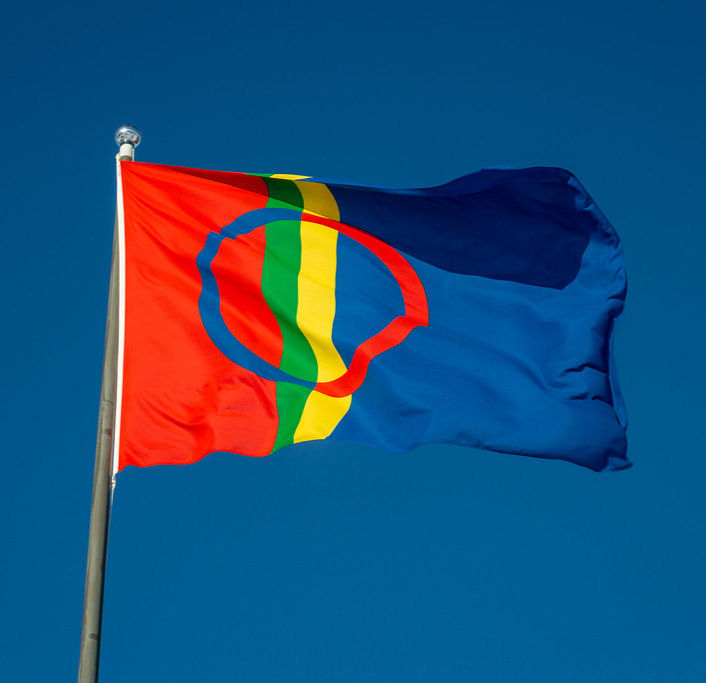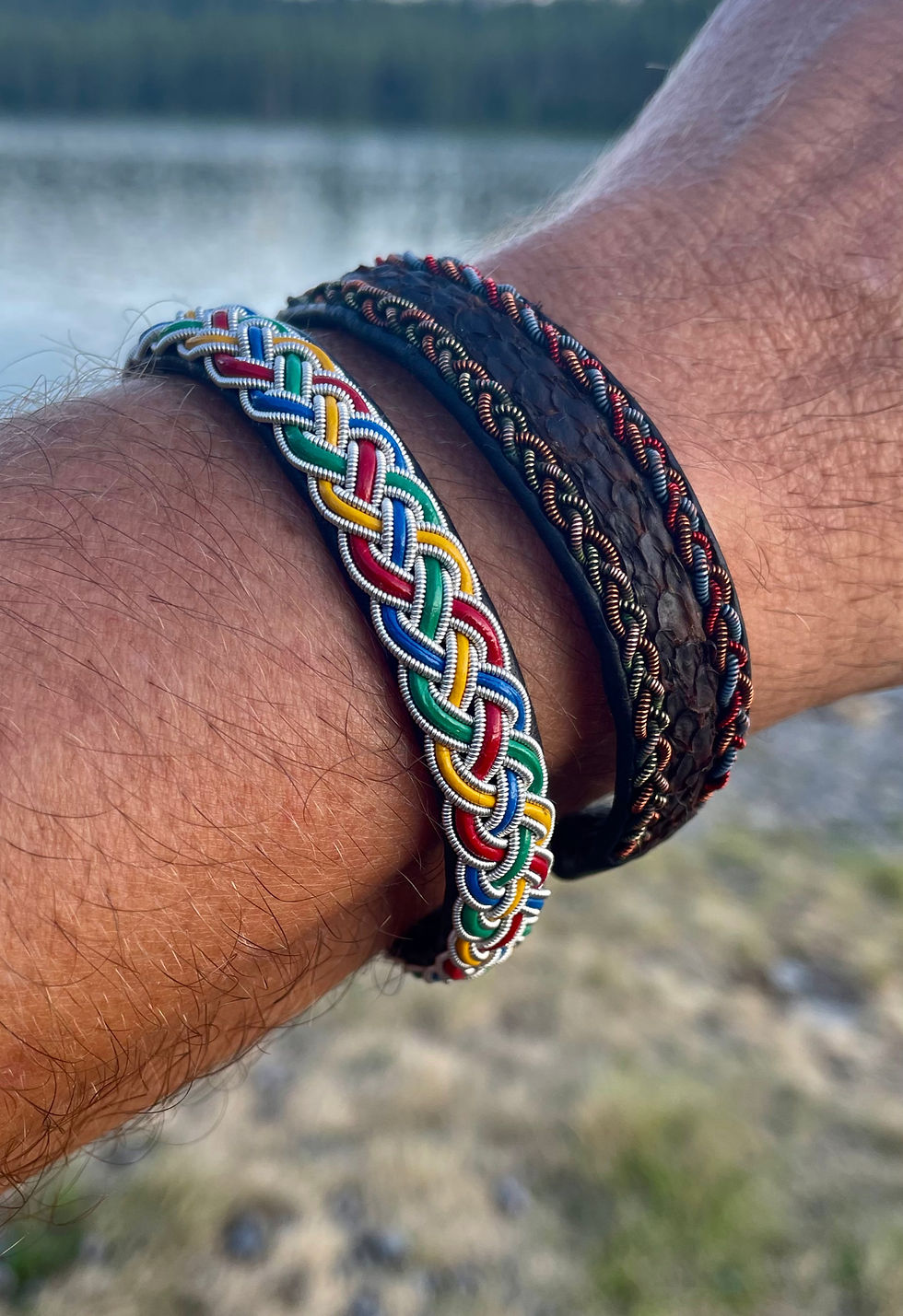Voice of the North: Samen
- Kelly & Richard

- Aug 22
- 4 min read
Updated: Sep 22
Driving through the far north, we can't escape the Sámi culture. Colorful flags flutter in the wind, reminding us of the original people who have called this place home for centuries. It's the last remaining indigenous culture in Europe. It's often thought that indigenous cultures are disappearing due to modernization, but nothing could be further from the truth.

In Lapland, Sámi culture is still very much alive. Reindeer herding, the joik and living with the seasons are still part of their way of life. And these days, they even have their own parliament.
Sápmi
The Sami live in the vast Sápmi region, which spans Norway, Sweden, Finland, and a small part of Russia. They were originally a nomadic people: in summer they herded reindeer into the mountains, and in winter they sought shelter in the forests.

History of oppression
The Sámi have long been oppressed and discriminated against by the government and the non-Sámi population. Under a policy of assimilation, they were forced to adapt to the prevailing culture and were not allowed to speak their language. Their faith was suppressed when the state church was imposed, and their culture was dismissed as "pagan." Racist theories even declared them an inferior race; skulls and bodies were measured to "prove" this. It is a dark chapter in Northern European history.
(Film tip: Sami Blood )
Excuse
In Norway apologized and established the Sámi Parliament. Sámi culture is currently experiencing a revival, with recognition of their culture and traditions, although challenges remain, such as conflicts over land and mining.

People in motion
Today, the situation has changed. The Sámen are modern, use quad bikes and snowmobiles to round up their reindeer, and are recognized by both the people and the government. Yet, their existence is anything but romantic: reindeer herding is hard and often dangerous work. Especially in the spring, when the reindeer need to be rounded up and the snow begins to melt, serious accidents occur regularly.
A fact that might surprise you: it's not done to ask a Sámi how many reindeer they own. That's like asking how much money someone has in their bank account.
Soul of the joik
One of the most beautiful expressions of Sámi culture is the joik. This style of singing is often wordless, yet it touches the soul directly. A joik can express emotions, people, animals, or nature in repetitive sounds and rhythms. Listen, for example, to this well-known joik song, written in honor of a deceased friend. It still gives us goosebumps.
Originally, joik was performed without instruments, except for the shaman's drum. During colonization, many shamans were murdered and their drums destroyed. Only a few examples remain on display in museums. Although shamans still exist, they often don't practice in public; the fear of the past runs deep.

Shamanism and sacred places
Shamanism, however, lives on. For example, a Sámi woman told us that as a baby, she cried inconsolably until her mother called upon a shaman for help. The shaman predicted that the girl would sleep uninterruptedly for 24 hours, after which the crying would cease. And so it happened.

Sacred rocks
Sacred places can be found throughout Sápmi. Rocks and mountains where people ask for help or make offerings. Around such a mountain, you often see artifacts lying around: crystals, notes, or other objects. According to the Sami, the rocks carry ancient wisdom; they were there long before humans and will still be there long after we are gone. Stone circles, which you encounter in the landscape, are also often ancient sacrificial sites.
"To joik someone is not to sing about them, but to let their spirit live in the sound."
But beware: don't anger the spirits. When a sacred rock was blown up during construction of the North Cape Tunnel, a Sámi reindeer herder warned in advance that this would bring bad luck. Avalanches, accidents, and fires soon followed. Finally, on the Sámi's advice, the contractor laid flowers at a nearby sacred rock to ask for forgiveness. Read the Norwegian article here .
Symbolism of the flag

Anyone driving into the far north can't miss it: the Sámi flag proudly flying from houses and public buildings. The flag reflects the colors of the traditional costume (gákti) and features a circle symbolizing the sun and moon, taken from ancient shamanic drums.
Red → fire
Blue → water
Green → nature
Yellow → sunlight
Circle → sun and moon

Samen or Inuit?
The Sami are sometimes confused with other indigenous peoples, such as the Inuit. There are similarities, but also clear differences. The Inuit live in Greenland, Canada, and Alaska and traditionally lived by fishing and hunting marine mammals, with the igloo as their iconic symbol. The Sami, on the other hand, are associated with reindeer herding in Northern Scandinavia and Russia. They lived primarily in tents (lavvu).
Mirror for ourselves
Sámi culture is sometimes still described as primitive, a label more often applied to indigenous cultures. But a closer look reveals something different. While the West often focuses on technology and economic growth, the Sámi live in balance with nature, community, and spirituality. They take only what is necessary from nature, do not pollute the air or soil, and possess a deep ecological knowledge. And then the question arises: what is truly primitive: a culture that lives in harmony with the earth, or one that exhausts it? Perhaps Sámi culture is a mirror in which we can recognize ourselves.
Previous Globus 2 videos featuring the Sami:
In this video we visited a souvenir shop of a real Sámi
In this video we took a walk to a Sami sacrificial mountain
In this video we see a Sami sacrificial circle
Enter your email address at the bottom of this page and you'll receive an email no more than once a week when we post a new blog post. If you'd like to support us financially so we can keep this website online, please donate via this link .





Comments